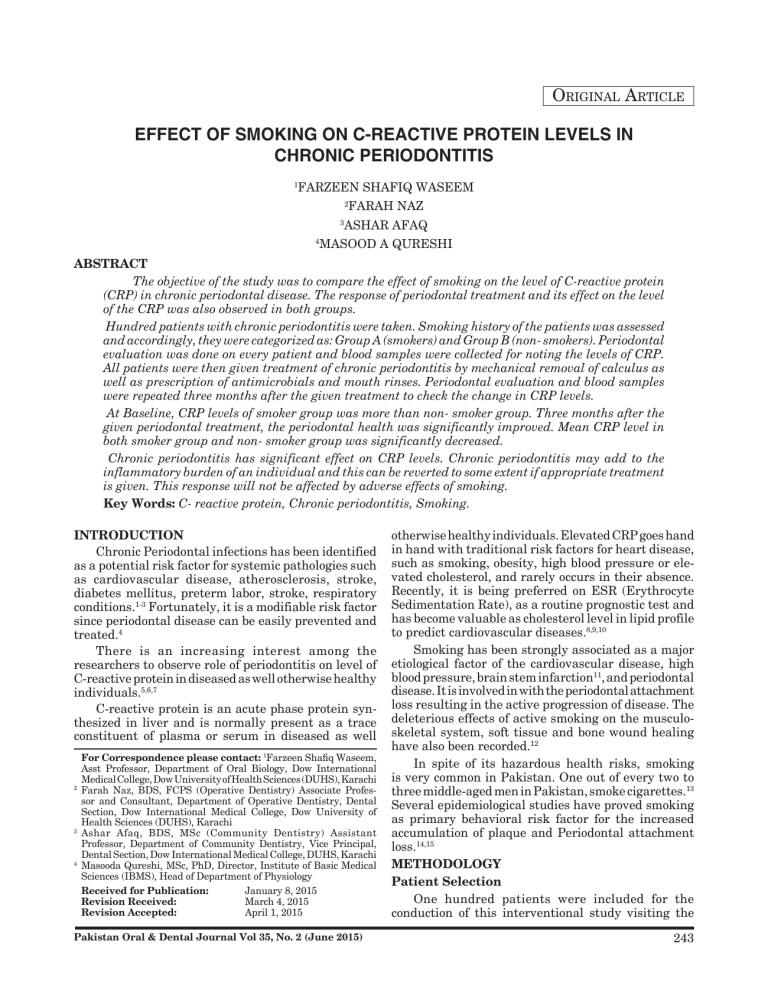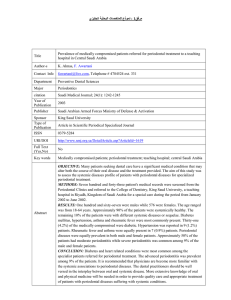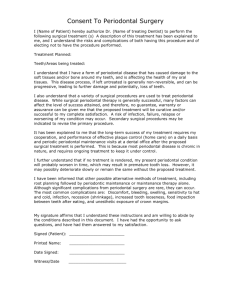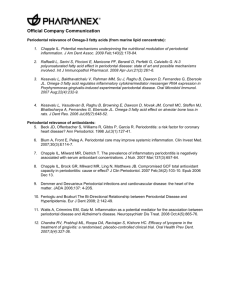effect of smoking on c-reactive protein levels in chronic periodontitis

O riginal
a rticle
EFFECT OF SMOKING ON C-REACTIVE PROTEIN LEVELS IN
CHRONIC PERIODONTITIS
1 FARZEEN SHAFIQ WASEEM
2 FARAH NAZ
3 ASHAR AFAQ
4 MASOOD A QURESHI
ABSTRACT
The objective of the study was to compare the effect of smoking on the level of C-reactive protein
(CRP) in chronic periodontal disease. The response of periodontal treatment and its effect on the level of the CRP was also observed in both groups.
Hundred patients with chronic periodontitis were taken. Smoking history of the patients was assessed and accordingly, they were categorized as: Group A (smokers) and Group B (non- smokers). Periodontal evaluation was done on every patient and blood samples were collected for noting the levels of CRP.
All patients were then given treatment of chronic periodontitis by mechanical removal of calculus as well as prescription of antimicrobials and mouth rinses. Periodontal evaluation and blood samples were repeated three months after the given treatment to check the change in CRP levels.
At Baseline, CRP levels of smoker group was more than non- smoker group. Three months after the given periodontal treatment, the periodontal health was significantly improved. Mean CRP level in both smoker group and non- smoker group was significantly decreased.
Chronic periodontitis has significant effect on CRP levels. Chronic periodontitis may add to the inflammatory burden of an individual and this can be reverted to some extent if appropriate treatment is given. This response will not be affected by adverse effects of smoking.
Key Words: C- reactive protein, Chronic periodontitis, Smoking.
INTRODUCTION
Chronic Periodontal infections has been identified as a potential risk factor for systemic pathologies such as cardiovascular disease, atherosclerosis, stroke, diabetes mellitus, preterm labor, stroke, respiratory conditions.
1-3 Fortunately, it is a modifiable risk factor since periodontal disease can be easily prevented and treated.
4
There is an increasing interest among the researchers to observe role of periodontitis on level of
C-reactive protein in diseased as well otherwise healthy individuals.
5,6,7
C-reactive protein is an acute phase protein syn thesized in liver and is normally present as a trace constituent of plasma or serum in diseased as well
For Correspondence please contact: 1 Farzeen Shafiq Waseem,
Asst Professor, Department of Oral Biology, Dow International
2
Medical College, Dow University of Health Sciences (DUHS), Karachi
Farah Naz, BDS, FCPS (Operative Dentistry) Associate Profes sor and Consultant, Department of Operative Dentistry, Dental
Section, Dow International Medical College, Dow University of
3
Health Sciences (DUHS), Karachi
Ashar Afaq, BDS, MSc (Community Dentistry) Assistant
Professor, Department of Community Dentistry, Vice Principal,
Dental Section, Dow International Medical College, DUHS, Karachi
4 Masooda Qureshi, MSc, PhD, Director, Institute of Basic Medical
Sciences (IBMS), Head of Department of Physiology
Received for Publication:
Revision Received:
Revision Accepted:
January 8, 2015
March 4, 2015
April 1, 2015
Pakistan Oral & Dental Journal Vol 35, No. 2 (June 2015) otherwise healthy individuals. Elevated CRP goes hand in hand with traditional risk factors for heart disease, such as smoking, obesity, high blood pressure or ele vated cholesterol, and rarely occurs in their absence.
Recently, it is being preferred on ESR (Erythrocyte
Sedimentation Rate), as a routine prognostic test and has become valuable as cholesterol level in lipid profile to predict cardiovascular diseases.
8,9,10
Smoking has been strongly associated as a major etiological factor of the cardiovascular disease, high blood pressure, brain stem infarction 11 , and periodontal disease. It is involved in with the periodontal attachment loss resulting in the active progression of disease. The deleterious effects of active smoking on the musculo skeletal system, soft tissue and bone wound healing have also been recorded.
12
In spite of its hazardous health risks, smoking is very common in Pakistan. One out of every two to three middle-aged men in Pakistan, smoke cigarettes.
13
Several epidemiological studies have proved smoking as primary behavioral risk factor for the increased accumulation of plaque and Periodontal attachment loss.
14,15
METHODOLOGY
Patient Selection
One hundred patients were included for the conduction of this interventional study visiting the
243
Smoking and CRP in Chronic Perodontitis
Periodontology Department of the Fatima Jinnah
Dental College, Karachi. The study protocols were approved by the Board of Ethical Committee of the institute. All participants signed written informed consent and the whole procedure was verbally explained to patient before inclusion in the study.. Patients having chronic periodontitis with a periodontal index of 6 and/ or 8 were selected for the study. Exclusion criteria were pregnancy, lactation, and pathologies such as diabetes mellitus, hypertension, asthma, epilepsy, and coronary artery disease, skin, or chronic diseases which can also increase the C-reactive protein levels.
Smoking history was assessed by the number of cigarettes smoked per day, the packs per month and the period since the person started smoking. The sub jects were then categorized as: Group A (smokers) and
Group B (nonsmokers) based on their smoking status.
Periodontal Evaluation
This was assured by four measures of periodontal status i.e. Periodontal pocket depth (PD) using a CPITN probe, Gingival Index (GI), Gingival bleeding on probing
(GB) and periodontal attachment level (AL). All four measurements were carried out in Ramford teeth and their mean values were determined for each patient, respectively. The readings were taken before treatment and three months after the treatment.
Determination of the C - reactive protein
In this study we used whole blood as a sample, as it needed no storage, and the results were obtained quickly at the chairside of patient. Blood samples were collected from all patients, before and after treatment for chronic periodontitis. NycoCard CRP Single Test kit was used for rapid determination of CRP C-reactive protein in human whole blood. The normal reference range for CRP in serum is usually reported as less than
0-5mg/L.
Periodontal Treatment
Chair side treatment included mechanical de bridement of the plaque and calculi by manual and ultrasonic scaling as well as deep curettage of gingi val and periodontal tissues. An antibiotic course of
Metronidazole 400mg 8 hourly was prescribed as it is very effective against most anaerobes involved in peri odontal diseases. The Antibiotic cover was given for 5 to 7 days, depending on the destruction of periodontal tissues that varied among patients. Proper brushing and flossing techniques were also demonstrated to the patient along with a prescription of a mouthwash con taining Chlorohexidine. After 3 months of periodontal treatment, the patients were recalled for the follow up.
On the follow up visit the periodontal evaluation was repeated and the blood sample was taken to check the change in CRP levels.
Stastical Analysis
The data was recorded in a proforma and anal ysis was done using SPSS version 16. Data analysis included descriptive statistics such as frequency dis tribution, percentage and cross tabulation. Wilcoxon signed matched paired test was applied to measure
Pakistan Oral & Dental Journal Vol 35, No. 2 (June 2015) the difference of periodontal index and CRP, before and after treatment. The level of significance was set at < 0.01 p-value. Mann-Whitney U test was applied to compare the periodontal index and the CRP between the smokers and nonsmokers.
RESULTS
Total number of patients was 100. There were 38 smokers and 62 non-smokers.
At Baseline
The CRP levels were relatively higher in the Group
A (smokers) than in the Group B (non-smokers). There were no significant differences in the reading of Peri odontal Index between both groups. (Table 1 and 2)
Three months after the given treatment
Three months after the given periodontal treatment the periodontal health was significantly improved as present in Table 1. The mean CRP level in smoker group was 6.79
± 2.8 and in nonsmokers 6.06
± 1.9 which was significantly decreased to 6.11 ± 2.5 and 5.23
± 1.6 respectively.
DISCUSSION
The chronic periodontitis is a local inflammatory disease resulting in the inflammation of the gums and repeated exposure of the bloodstream to bacterial invasion leading to bacteremia. Tooth brushing, Tooth
TABLE 1: THE CRP LEVELS COMPARED
AMONG SMOKERS AND NON-SMOKERS
CRP
Before treatment After treatment
Smokers 6.79
SD 2.8
Range 2-12
Non-smok ers
6.06
SD 1.9
Range 2-12
*6.11
SD 2.5
Range 2-12
*5.23
SD 1.6
Range 2-1
Values are expressed as Mean, standard deviation (SD) and *P<0.0001 as compared To CRP levels before and after periodontal treatment
TABLE 2: THE PERIODONTAL INDEX
COMPARED AMONG SMOKERS AND
NON-SMOKERS
CRP
Before treatment After treatment
Smokers 7.21
SD 0.99
Range 6-8
Non-smok ers
7.35
SD 0.94
Range 6-8
*4.42
SD 1.98
Range 2-6
*4.6
SD 1.91
Range 2-6
Values are expressed as Mean, standard deviation (SD) and *P<0.0001 as compared to Periodontal Index (PI) before and after periodontal treatment.
244
Smoking and CRP in Chronic Perodontitis extractions, and periodontal therapy may be the reason of the entrance of bacteria in the blood circulation.
16
The chronic infections leads to the activation of our immune system; thus releasing the C-reactive protein in the bloodstream.
17, 18 Chronic periodontitis triggers the level of CRP, IL-6, thus increasing the cardiovascular diseases.
1 The combination of smoking, periodontal disease can increase the systemic CRP level to a level that is very risky for health. In our study we tried to disclose some aspects of association among these three parameters.
In present study the periodontal index was not poor in smokers as compared to non- smokers as we expected. This controversial result may be due to the fact that in smokers localized vascular dysfunction and reduced gingival blood flow decreases the localized inflammation of gums.
The gingival blood flow is again dependent on the number of the cigarettes, age and mode of smoking.
19
The oral hygiene practices of the individual may also balance out the destructive effect caused by the smoking on the periodontal health.
Tobacco is known for reducing the blood supply to gums depriving them of oxygen and nutrients, leaving them vulnerable to the bacterial infections.
20,21 Smoking increases the CRP by its effect on the accumulation of plaque and effects on the host response. Jennifer
O’Loghlin et al have shown positive relationship be tween smoking status and elevated CRP in adolescents, and in particular among the heavier smokers.
22 Rima
Azar, also proved that the active and passive smoking, both can result in the elevation of CRP levels.
23 Kristina
Bertl et al have shown that smoking increases the sali vary Histamine and CRP levels in periodontal disease.
In the present study CRP levels were quite high in the smokers, 24 which is in line with above studies.
CONCLUSION
Chronic periodontitis has significant effect on
CRP levels. Periodontal Treatment decreased the CRP level in smokers as well as non-smokers. Our study concluded that the chronic periodontitis may add to the inflammatory burden of an individual and this can be reverted to some extent if appropriate treatment is given.
Our study proved that if the proper periodontal management is provided to the patient the response to this treatment in terms of periodontal health will not be effected by the adverse effect of smoking.
REFERENCES
1 D’Aiuto F, Ready D, Tonetti MS. Periodontal disease and C-reactive protein-associated cardiovascular risk. J
Periodontal Res. 2004; 39(4): 236-41.
2 Page RC, The pathobiology of periodontal diseases may affect systemic diseases: inversion of paradigm. Ann Periodontal 1998:
3: 108.
3 Mealey BL: Influence of Periodontal infections on systemic health. Periodontol 2000. 1999; 21: 197-209.
4 Lee HJ, Garcia RI, Janket SJ, Jones JA, Mascarenhas AK, Scott
TE , Nunn ME. The association between cumulative periodontal disease and stroke history in older adults. J Periodontol. 2006;
77(10): 1744-54.
5 Thakare KS, Deo V, Bhongade ML. Evaluation of the C-reactive protein serum levels in periodontitis patients with or without atherosclerosis. Indian J Dent Res. 2010; 21(3): 326-29.
6 Vidal F, Figueredo CM, Cordovil I, Fischer RG.
Periodontal therapy reduces plasma levels of interleukin-6,
C-reactive protein, and fibrinogen in patients with severe periodontitis and refractory arterial hypertension. J
Periodontol. 2009; 80(5): 786-91.
7 Marcaccini AM, Meschiari CA, Sorgi CA, Saraiva MC, de
Souza AM, Faccioli LH, Tanus-Santos JE, Novaes AB, Gerlach
RF Circulating interleukin-6 and high-sensitivity C-reactive protein decrease after periodontal therapy in otherwise healthy subjects. J Periodontol. 2009; 80(4): 594-602.
8 Peppys MB. The acute phase response and C-reactive protein.
The oxford textbook of Medicine1996 Ed. 3, Vol 2. pp. 1527-33.
9 Benzaquen LR, Yu H, Rifai N .High sensitivity C-reactive protein: an emerging role in cardiovascular risk assessment.
Crit Rev Clin Lab Sci. 2002; 39(4-5): 459-97.
10 Ridker PM, Rifai N, Rose L, Buring JE, Cook NR. Comparison of C-reactive protein and low-density lipoprotein cholesterol levels in the prediction of first cardiovascular events. N Engl J
Med. 2002 14; 347(20): 1557-65.
11 Duthon VB, Ozturk M, El-Achachi S, Menetrey J. Deleterious effects of smoking on the musculoskeletal system. Rev Med
Suisse. 2014; 16: 10(437): 1466-71.
12 Hoogendoorn JM, van der Werken C. The adverse effects of smoking on healing of open tibial fractures. Ned Tijdschr
Geneeskd. 2002; 31; 146(35): 1640-4.
13 Ahmad K, Jafary F, Jehan I, Hatcher J, Khan AQ, Chaturvedi
N , Jafar TH. Prevalence and predictors of smoking in Pakistan: results of the National Health Survey of Pakistan. Eur J
Cardiovasc Prev Rehabil. 2005; 12(3): 203-08.
14 Duane B. Further evidence that periodontal bone loss increases with smoking and age. Evid Based Dent. 2014; 15(3): 72-73.
15 Thomson WM, Broadbent JM, Welch D, Beck JD, Poulton R.
Cigarette smoking and periodontal disease among 32-year-old: a prospective study of a representative birth cohort. J Clin
Periodontol. 2007; 34(10): 828-34.
16 Maharaj B, Coovadia Y, Vayej AC. An investigation of the frequency of bacteraemia following dental extraction, tooth brushing and chewing. Cardiovasc J Afr. 2012; 23(6): 340-44.
17 Nordestgaard BG, Zacho J; Lipids,atherosclerosis and CVD risk: Is CRP an innocent bystander? Nutr Metab Cardiovasc
Dis. 2009, 19: 521-24.
18 Azar R, Richard A. Elevated salivary C-reactive protein levels are associated with active and passive smoking in healthy youth:
A pilot study. J Inflamm (Lond). 2011; 7; 8(1): 37.
19 Mavropoulos A, Brodin P, Rösing CK, Aass AM, Aars H.
Gingival blood flow in periodontitis patients before and after periodontal surgery assessed in smokers and non-smokers. J
Periodontol. 2007; 78(9): 1774-82.
20 Johnson GK, Hill M. Cigarette smoking and the periodontal patient. J Periodontol. 2004; 75(2): 196-209.
21 Amarasena N, Ekanayaka AN, Herath L, Miyazaki H.Tobacco use and oral hygiene as risk indicators for periodontitis.
Community Dent Oral Epidemiol. 2002; 30(2): 115-23.
22 O’Loughlin J, Lambert M, Karp I, McGrath J, Gray-Donald K,
Barnett TA, Delvin EE, Levy E, Paradis G.Association between cigarette smoking and C-reactive protein in a representative, population-based sample of adolescents. Nicotine Tob Res. 2008;
10(3): 525-32.
23 Azar Rand, Richard A. Elevated salivary C-reactive protein levels are associated with active and passive smoking in healthy youth: A pilot study J Inflamm (Lond). 2011; 8: 37.
24 Bertl K, HaririanH, Laky M, Matejka M, Andrukhov O, Raush-
Fan X: Smoking influences the salivary histamine levels in periodontal disease. Oral Dis. 2012; 18(4): 410-6.
Pakistan Oral & Dental Journal Vol 35, No. 2 (June 2015) 245







